MITSUBISHI SHOGUN 2016 Owner's Manual (in English)
Manufacturer: MITSUBISHI, Model Year: 2016, Model line: SHOGUN, Model: MITSUBISHI SHOGUN 2016Pages: 404, PDF Size: 18.95 MB
Page 301 of 404
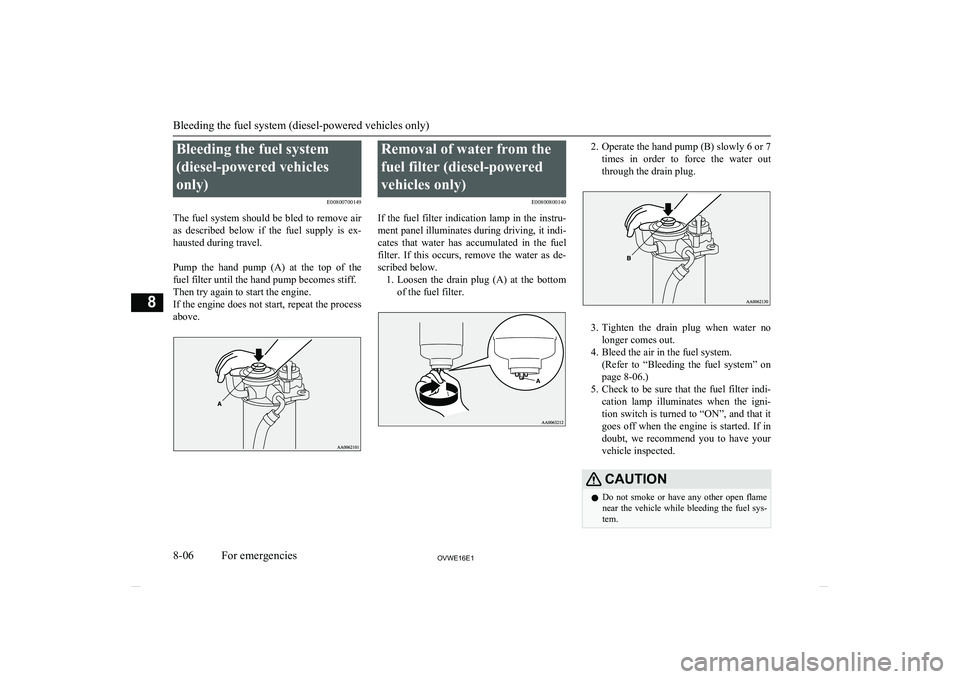
Bleeding the fuel system(diesel-powered vehicles
only) E00800700149
The fuel system should be bled to remove air
as described below if the fuel supply is ex- hausted during travel.
Pump the hand pump (A) at the top of the fuel filter until the hand pump becomes stiff.
Then try again to start the engine.
If the engine does not start, repeat the process
above.Removal of water from the
fuel filter (diesel-powered
vehicles only) E00800800140
If the fuel filter indication lamp in the instru- ment panel illuminates during driving, it indi-
cates that water has accumulated in the fuel filter. If this occurs, remove the water as de-
scribed below. 1. Loosen the drain plug (A) at the bottom
of the fuel filter.2. Operate the hand pump (B) slowly 6 or 7
times in order to force the water out
through the drain plug.
3. Tighten the drain plug when water no
longer comes out.
4. Bleed the air in the fuel system. (Refer to “Bleeding the fuel system” onpage 8-06.)
5. Check to be sure that the fuel filter indi-
cation lamp illuminates when the igni-
tion switch is turned to “ON”, and that it goes off when the engine is started. If in
doubt, we recommend you to have your vehicle inspected.
CAUTIONl Do not smoke or have any other open flame
near the vehicle while bleeding the fuel sys- tem.
Bleeding the fuel system (diesel-powered vehicles only)
8-06OVWE16E1For emergencies8
Page 302 of 404
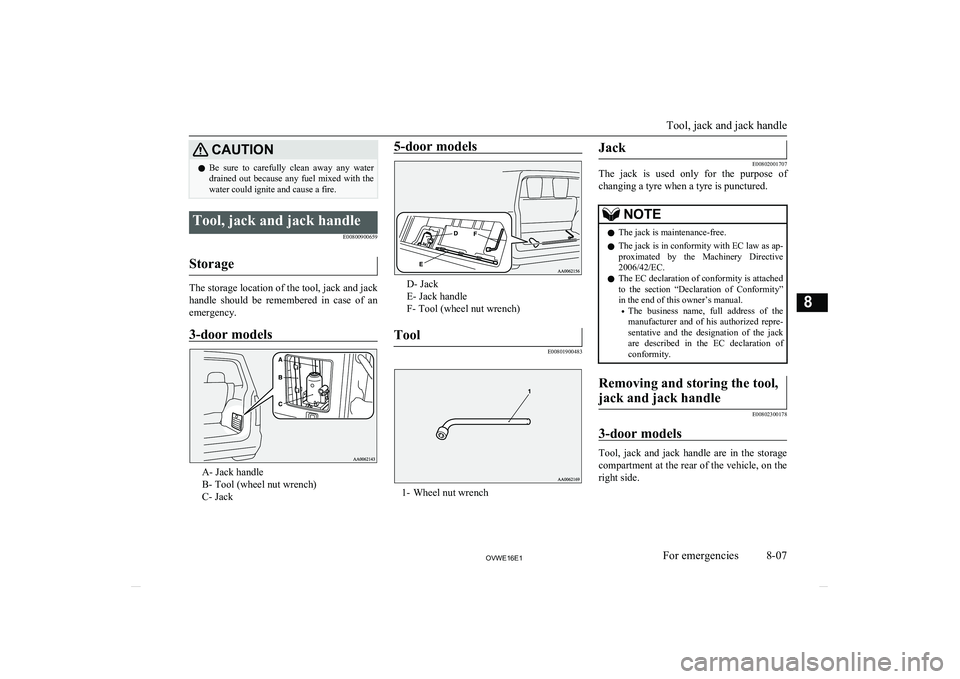
CAUTIONlBe sure to carefully clean away any water
drained out because any fuel mixed with the
water could ignite and cause a fire.Tool, jack and jack handle
E00800900659
Storage
The storage location of the tool, jack and jack
handle should be remembered in case of an
emergency.
3-door models
A- Jack handle
B- Tool (wheel nut wrench)
C- Jack
5-door models
D- Jack
E- Jack handle
F- Tool (wheel nut wrench)
Tool
E00801900483
1- Wheel nut wrench
Jack
E00802001707
The jack is used only for the purpose of
changing a tyre when a tyre is punctured.
NOTEl The jack is maintenance-free.
l The jack is in conformity with EC law as ap-
proximated by the Machinery Directive
2006/42/EC.
l The EC declaration of conformity is attached
to the section “Declaration of Conformity”
in the end of this owner’s manual.
• The business name, full address of the
manufacturer and of his authorized repre-
sentative and the designation of the jack are described in the EC declaration of
conformity.Removing and storing the tool,
jack and jack handle
E00802300178
3-door models
Tool, jack and jack handle are in the storage
compartment at the rear of the vehicle, on the right side.
Tool, jack and jack handle
8-07OVWE16E1For emergencies8
Page 303 of 404
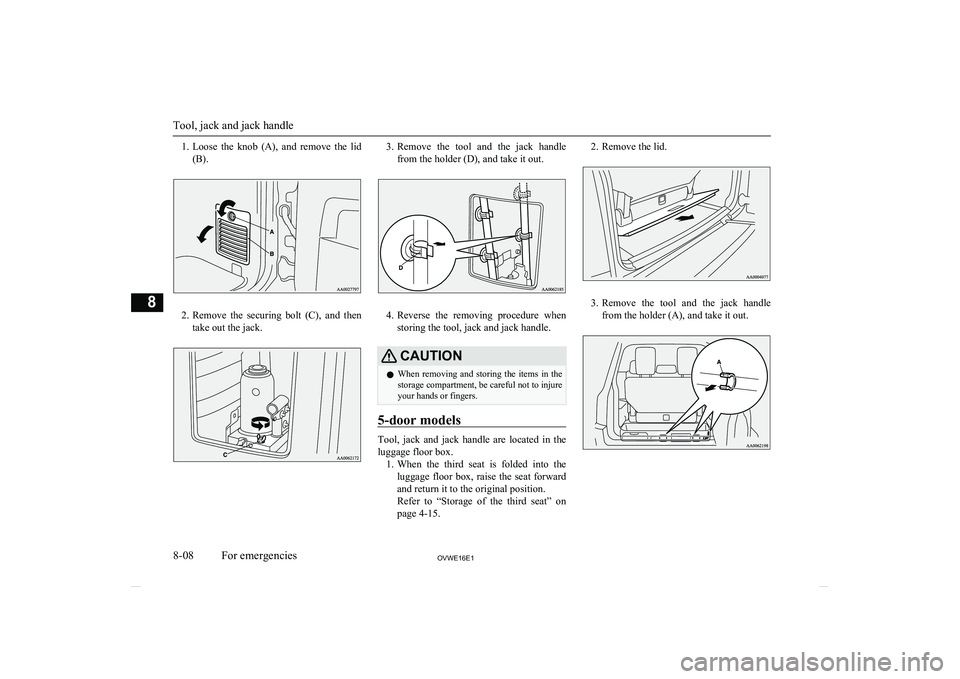
1.Loose the knob (A), and remove the lid
(B).
2. Remove the securing bolt (C), and then
take out the jack.
3. Remove the tool and the jack handle
from the holder (D), and take it out.
4. Reverse the removing procedure when
storing the tool, jack and jack handle.
CAUTIONl When removing and storing the items in the
storage compartment, be careful not to injure
your hands or fingers.
5-door models
Tool, jack and jack handle are located in the
luggage floor box. 1. When the third seat is folded into the
luggage floor box, raise the seat forward and return it to the original position.
Refer to “Storage of the third seat” on
page 4-15.
2. Remove the lid.
3. Remove the tool and the jack handle
from the holder (A), and take it out.
Tool, jack and jack handle
8-08OVWE16E1For emergencies8
Page 304 of 404
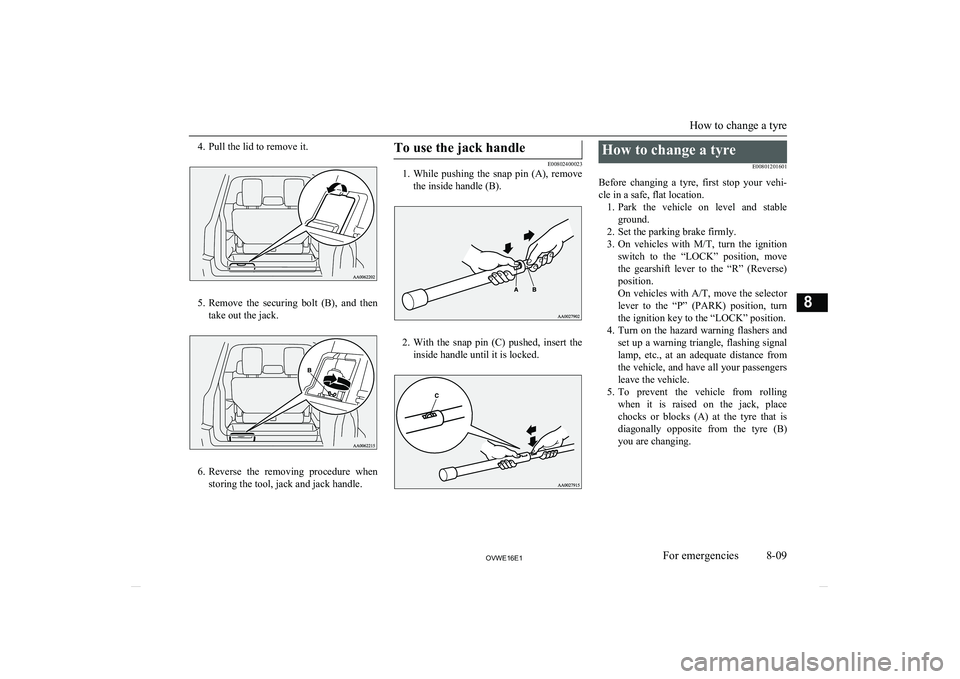
4. Pull the lid to remove it.
5.Remove the securing bolt (B), and then
take out the jack.
6. Reverse the removing procedure when
storing the tool, jack and jack handle.
To use the jack handle
E00802400023
1. While pushing the snap pin (A), remove
the inside handle (B).
2. With the snap pin (C) pushed, insert the
inside handle until it is locked.
How to change a tyre
E00801201601
Before changing a tyre, first stop your vehi- cle in a safe, flat location. 1. Park the vehicle on level and stable
ground.
2. Set the parking brake firmly.
3. On vehicles with M/T, turn the ignition
switch to the “LOCK” position, move the gearshift lever to the “R” (Reverse)position.
On vehicles with A/T, move the selector
lever to the “P” (PARK) position, turn the ignition key to the “LOCK” position.
4. Turn on the hazard warning flashers and
set up a warning triangle, flashing signal
lamp, etc., at an adequate distance from
the vehicle, and have all your passengers
leave the vehicle.
5. To prevent the vehicle from rolling
when it is raised on the jack, place
chocks or blocks (A) at the tyre that is diagonally opposite from the tyre (B)
you are changing.
How to change a tyre
8-09OVWE16E1For emergencies8
Page 305 of 404
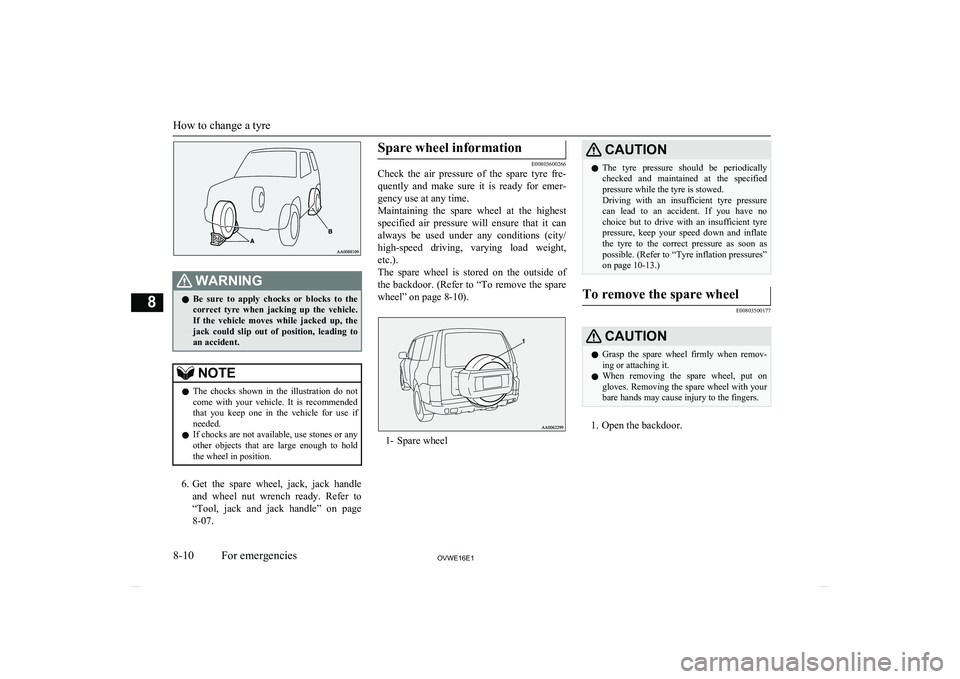
WARNINGlBe sure to apply chocks or blocks to the
correct tyre when jacking up the vehicle.If the vehicle moves while jacked up, the
jack could slip out of position, leading to
an accident.NOTEl The chocks shown in the illustration do not
come with your vehicle. It is recommended
that you keep one in the vehicle for use if needed.
l If chocks are not available, use stones or any
other objects that are large enough to hold the wheel in position.
6. Get the spare wheel, jack, jack handle
and wheel nut wrench ready. Refer to “Tool, jack and jack handle” on page8-07.
Spare wheel information
E00803600266
Check the air pressure of the spare tyre fre-
quently and make sure it is ready for emer-
gency use at any time.
Maintaining the spare wheel at the highest specified air pressure will ensure that it can
always be used under any conditions (city/ high-speed driving, varying load weight,etc.).
The spare wheel is stored on the outside of
the backdoor. (Refer to “To remove the spare wheel” on page 8-10).
1- Spare wheel
CAUTIONl The tyre pressure should be periodically
checked and maintained at the specified pressure while the tyre is stowed.
Driving with an insufficient tyre pressure can lead to an accident. If you have no
choice but to drive with an insufficient tyre pressure, keep your speed down and inflatethe tyre to the correct pressure as soon as
possible. (Refer to “Tyre inflation pressures”
on page 10-13.)To remove the spare wheel
E00803500177
CAUTIONl Grasp the spare wheel firmly when remov-
ing or attaching it.
l When removing the spare wheel, put on
gloves. Removing the spare wheel with your
bare hands may cause injury to the fingers.
1. Open the backdoor.
How to change a tyre
8-10OVWE16E1For emergencies8
Page 306 of 404
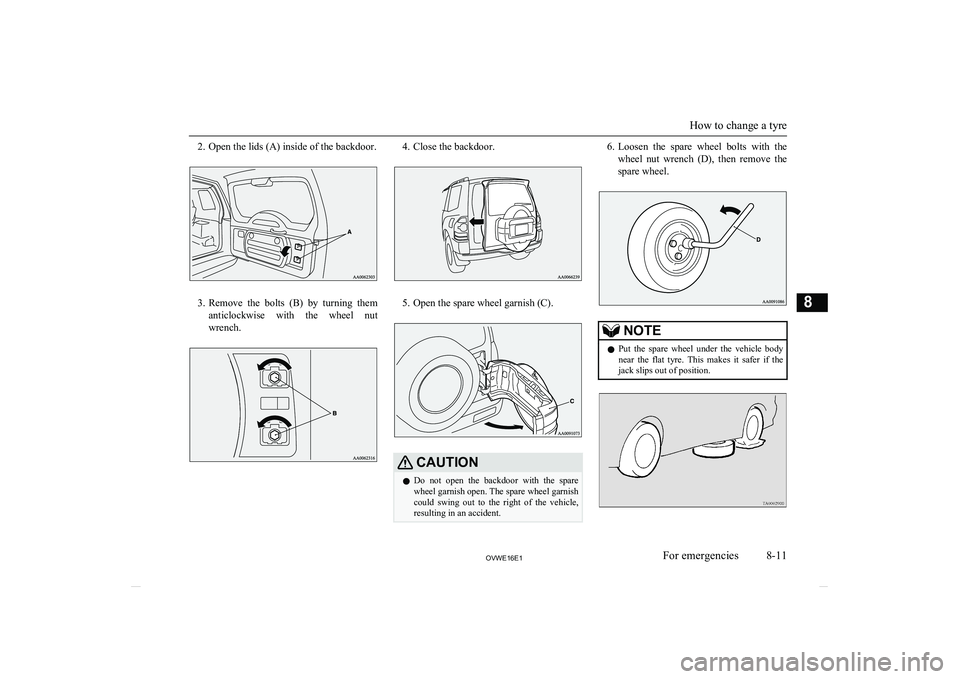
2. Open the lids (A) inside of the backdoor.
3.Remove the bolts (B) by turning them
anticlockwise with the wheel nut
wrench.
4. Close the backdoor.
5. Open the spare wheel garnish (C).
CAUTIONl Do not open the backdoor with the spare
wheel garnish open. The spare wheel garnish
could swing out to the right of the vehicle, resulting in an accident.6. Loosen the spare wheel bolts with the
wheel nut wrench (D), then remove the spare wheel.NOTEl Put the spare wheel under the vehicle body
near the flat tyre. This makes it safer if the jack slips out of position.
How to change a tyre
8-11OVWE16E1For emergencies8
Page 307 of 404
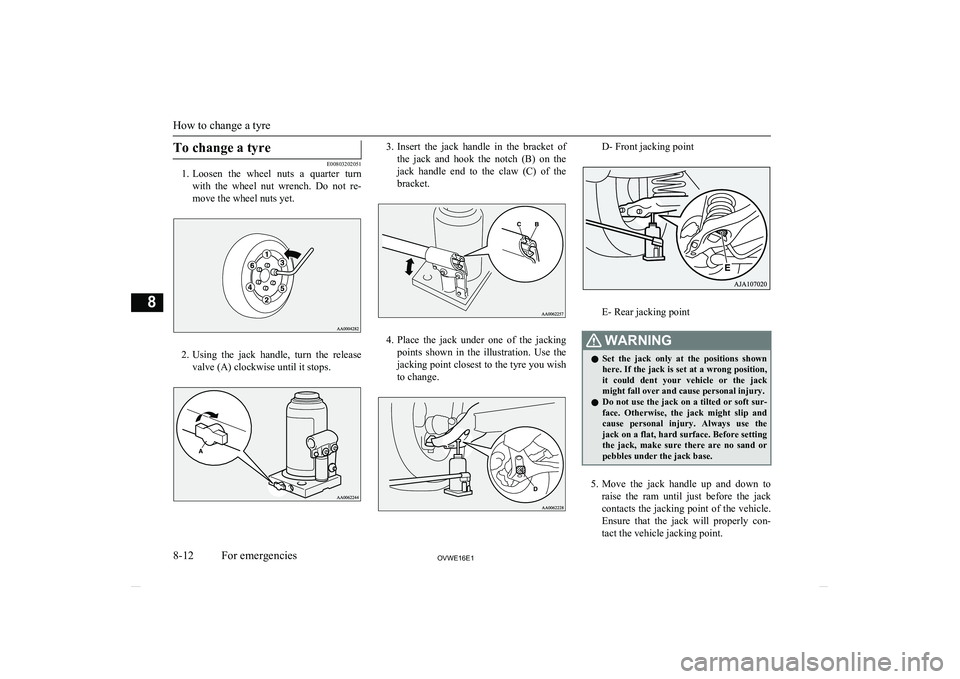
To change a tyre
E00803202051
1. Loosen the wheel nuts a quarter turn
with the wheel nut wrench. Do not re- move the wheel nuts yet.
2. Using the jack handle, turn the release
valve (A) clockwise until it stops.
3. Insert the jack handle in the bracket of
the jack and hook the notch (B) on the
jack handle end to the claw (C) of the bracket.
4. Place the jack under one of the jacking
points shown in the illustration. Use the jacking point closest to the tyre you wish
to change.
D- Front jacking point
E- Rear jacking point
WARNINGl Set the jack only at the positions shown
here. If the jack is set at a wrong position, it could dent your vehicle or the jack
might fall over and cause personal injury.
l Do not use the jack on a tilted or soft sur-
face. Otherwise, the jack might slip and cause personal injury. Always use the jack on a flat, hard surface. Before setting
the jack, make sure there are no sand or pebbles under the jack base.
5. Move the jack handle up and down to
raise the ram until just before the jack contacts the jacking point of the vehicle.
Ensure that the jack will properly con- tact the vehicle jacking point.
How to change a tyre
8-12OVWE16E1For emergencies8
Page 308 of 404
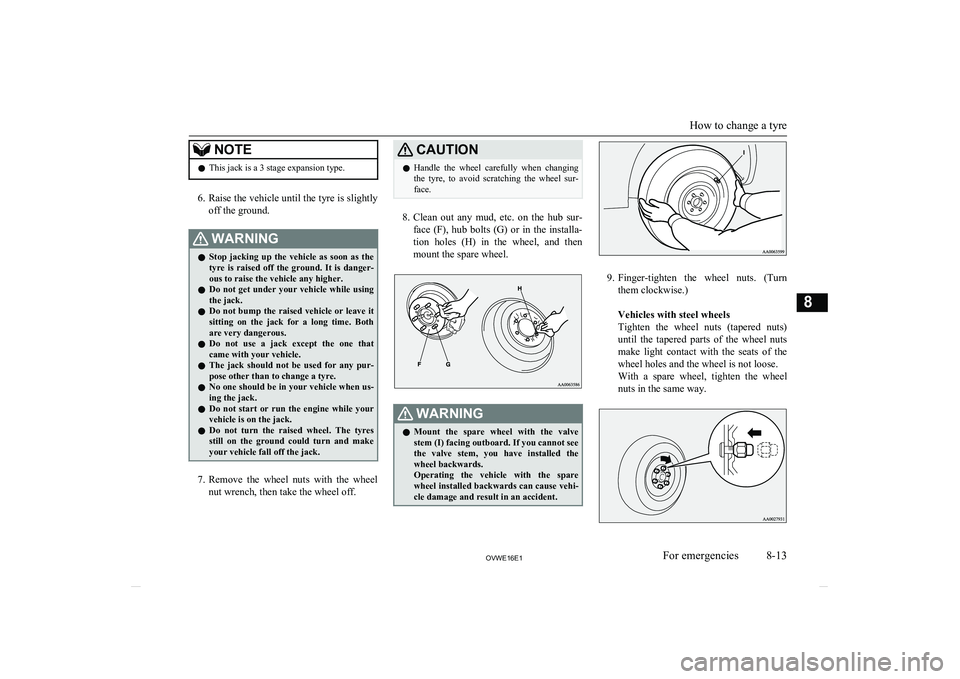
NOTElThis jack is a 3 stage expansion type.
6.
Raise the vehicle until the tyre is slightly
off the ground.
WARNINGl Stop jacking up the vehicle as soon as the
tyre is raised off the ground. It is danger-
ous to raise the vehicle any higher.
l Do not get under your vehicle while using
the jack.
l Do not bump the raised vehicle or leave it
sitting on the jack for a long time. Both are very dangerous.
l Do not use a jack except the one that
came with your vehicle.
l The jack should not be used for any pur-
pose other than to change a tyre.
l No one should be in your vehicle when us-
ing the jack.
l Do not start or run the engine while your
vehicle is on the jack.
l Do not turn the raised wheel. The tyres
still on the ground could turn and make your vehicle fall off the jack.
7. Remove the wheel nuts with the wheel
nut wrench, then take the wheel off.
CAUTIONl Handle the wheel carefully when changing
the tyre, to avoid scratching the wheel sur- face.
8. Clean out any mud, etc. on the hub sur-
face (F), hub bolts (G) or in the installa- tion holes (H) in the wheel, and then
mount the spare wheel.
WARNINGl Mount the spare wheel with the valve
stem (I) facing outboard. If you cannot see
the valve stem, you have installed the wheel backwards.
Operating the vehicle with the spare
wheel installed backwards can cause vehi-
cle damage and result in an accident.
9. Finger-tighten the wheel nuts. (Turn
them clockwise.)
Vehicles with steel wheels
Tighten the wheel nuts (tapered nuts)
until the tapered parts of the wheel nuts make light contact with the seats of the wheel holes and the wheel is not loose.
With a spare wheel, tighten the wheel
nuts in the same way.
How to change a tyre
8-13OVWE16E1For emergencies8
Page 309 of 404
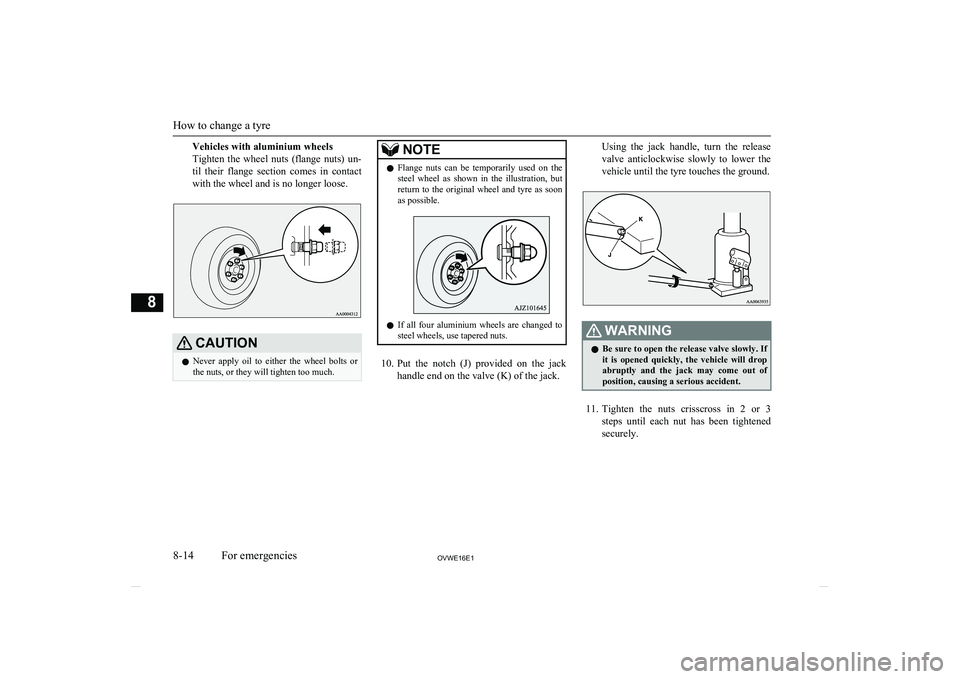
Vehicles with aluminium wheels
Tighten the wheel nuts (flange nuts) un-
til their flange section comes in contact with the wheel and is no longer loose.CAUTIONl Never apply oil to either the wheel bolts or
the nuts, or they will tighten too much.NOTEl Flange nuts can be temporarily used on the
steel wheel as shown in the illustration, but return to the original wheel and tyre as soonas possible.
l If all four aluminium wheels are changed to
steel wheels, use tapered nuts.
10. Put the notch (J) provided on the jack
handle end on the valve (K) of the jack.
Using the jack handle, turn the release
valve anticlockwise slowly to lower thevehicle until the tyre touches the ground.WARNINGl Be sure to open the release valve slowly. If
it is opened quickly, the vehicle will drop
abruptly and the jack may come out of
position, causing a serious accident.
11. Tighten the nuts crisscross in 2 or 3
steps until each nut has been tightened
securely.
How to change a tyre
8-14OVWE16E1For emergencies8
Page 310 of 404
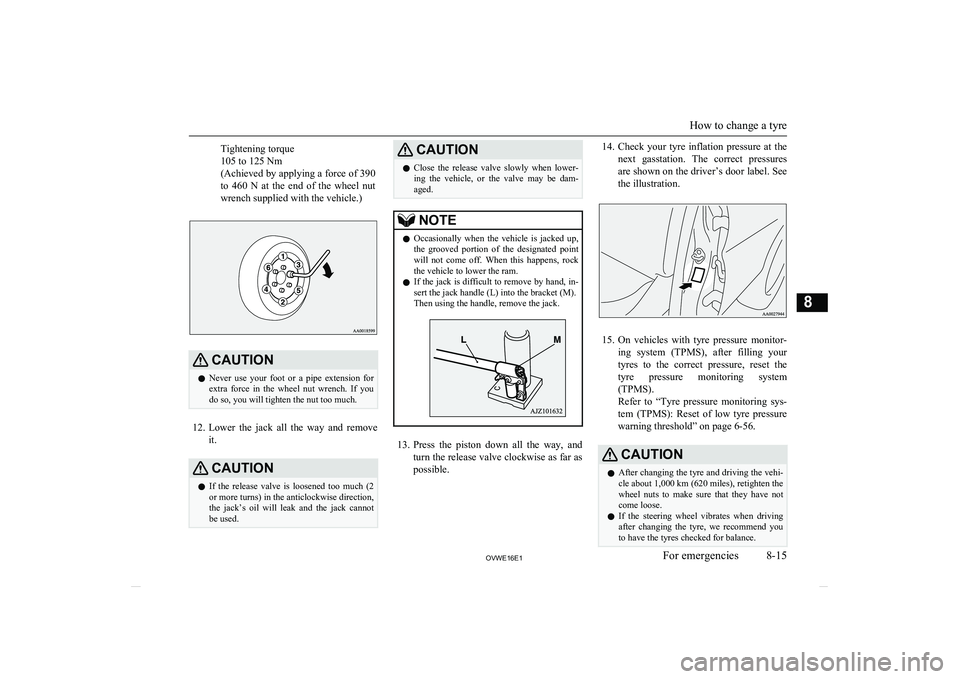
Tightening torque
105 to 125 Nm
(Achieved by applying a force of 390
to 460 N at the end of the wheel nut wrench supplied with the vehicle.)CAUTIONl Never use your foot or a pipe extension for
extra force in the wheel nut wrench. If you
do so, you will tighten the nut too much.
12. Lower the jack all the way and remove
it.
CAUTIONl If the release valve is loosened too much (2
or more turns) in the anticlockwise direction, the jack’s oil will leak and the jack cannotbe used.CAUTIONl Close the release valve slowly when lower-
ing the vehicle, or the valve may be dam-
aged.NOTEl Occasionally when the vehicle is jacked up,
the grooved portion of the designated pointwill not come off. When this happens, rock
the vehicle to lower the ram.
l If the jack is difficult to remove by hand, in-
sert the jack handle (L) into the bracket (M).Then using the handle, remove the jack.
13. Press the piston down all the way, and
turn the release valve clockwise as far as possible.
14. Check your tyre inflation pressure at the
next gasstation. The correct pressures
are shown on the driver’s door label. See the illustration.
15. On vehicles with tyre pressure monitor-
ing system (TPMS), after filling your tyres to the correct pressure, reset the tyre pressure monitoring system(TPMS).
Refer to “Tyre pressure monitoring sys-
tem (TPMS): Reset of low tyre pressure
warning threshold” on page 6-56.
CAUTIONl After changing the tyre and driving the vehi-
cle about 1,000 km (620 miles), retighten the
wheel nuts to make sure that they have not come loose.
l If the steering wheel vibrates when driving
after changing the tyre, we recommend you to have the tyres checked for balance.
How to change a tyre
8-15OVWE16E1For emergencies8